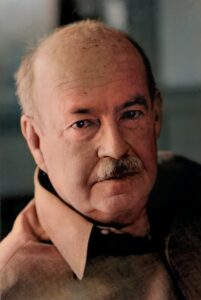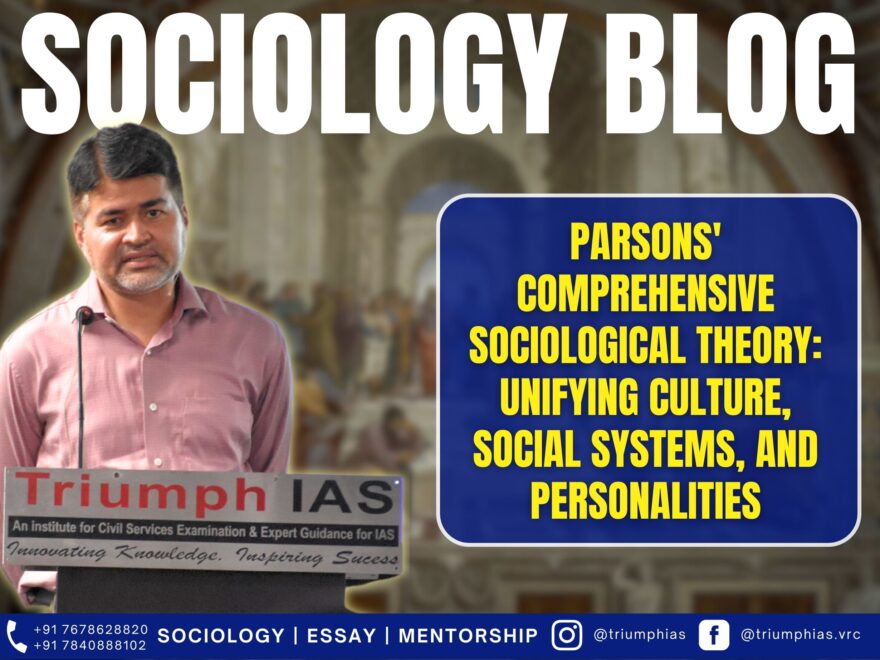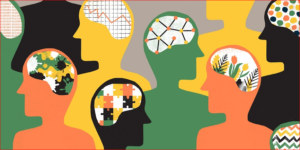
Theory not only formulates what we know but also tells us what we want to know, that is, the questions to which an answer is needed.
Social System
Relevant for Sociology Paper-1 (Unit-4)
Parsons presents a comprehensive sociological theory that encompasses both simple primitive societies and complex modern industrial societies. He develops his theory by examining the social system from the perspective of social action, which is an integral component of the overall system. Parsons emphasizes the integrative nature of the social system, highlighting the role of motivational factors, including utilitarian perspectives and values, in its formation.
According to Parsons, action cannot be viewed in isolation but is interconnected within constellations, forming a system. He derives the concept of action from the behavior of individuals as living organisms, who interact with the external reality and within their own minds.
Behavior becomes action when four conditions are present:
Action is directed towards achieving specific goals or anticipated outcomes. It takes place within specific situations and is influenced by societal norms and values. Additionally, action requires the investment of energy, motivation, or effort.
For instance, consider a woman driving her car to go to a temple with the intention of offering prayers. In this scenario, her goal is to engage in prayer, and her orientation is towards fulfilling this objective. The situation encompasses the road she is driving on and the car she is sitting in. Furthermore, her behavior is guided by social norms that recognize prayer as a desirable activity. She also applies her learned driving skills, acquired from society, to operate the vehicle effectively. Lastly, the act of driving the car itself involves exertion of energy, such as holding the wheel, managing the accelerator, and skillfully navigating through traffic. When we examine behavior in this analytical framework, it can be classified as action.
As mentioned previously, according to Parsons, action does not occur in isolation but exists within constellations. These constellations of action form systems. These systems of action encompass three modes of organization: the personality system, the cultural system, and the social system.
He proposed that the actual operating life of a society is made up of the following elements:
The cultural system consists of abstract behavioral patterns that dictate the appropriate actions individuals should take in specific situations. An example of this is the highway code, which sets guidelines on driving speeds, conditions, and coordination with other drivers.
The social system encompasses the actual behaviors of individuals in real-life situations, aligning (to a certain extent) with the abstract patterns mentioned earlier. For instance, drivers on the road are actively observing and adapting their driving to accommodate and avoid other motorists, based on the conventions outlined in the highway code that are generally followed by most, if not all, drivers.
The personality system pertains to the unique characteristics and behavioral tendencies of individuals who carry out these patterns. In the context of traffic, people exhibit their personalities as drivers and interact with one another accordingly. Some individuals drive at higher speeds, while others demonstrate greater respect for others’ rights on the road. Some may become frustrated with traffic conditions, while others remain calm and composed.
Nevertheless, the vast majority of these drivers generally adhere to the principles of road regulations (Motivated Compliance), not solely out of caution for their own safety or through calculated assessments of how much following the rules would maximize their self-interest, but because they believe it is the morally correct course of action. They perceive these rules as obligations that apply not only to themselves but also to others. They may even feel righteous anger towards other drivers who demonstrate a lack of respect for the rules of the road, even if such violations pose no direct danger or harm to them.
The concept of “motivated compliance” simply refers to drivers being motivated to follow the rules outlined in the highway code. This example highlights the way real-life situations in society can be understood as comprising three distinct “action systems,” as Parsons termed them:
- Cultural System – This encompasses the abstract framework of ideas, principles, and norms that dictate how individuals should conduct themselves.
- Social System – This involves the organized patterns of activity and relationships among individuals as they interact and collaborate with one another in their daily pursuits.
- Personality System – This refers to the psychological makeup of individuals, which influences their behavior, actions, and responses to others in practical situations.
- According to Parsons, any society must find a way to effectively integrate these three elements.
Integrating culture, social system and personalities
Somehow, things will have to work out so that:
Culture sets guidelines for human behavior that align with practical effectiveness, taking into account people’s desires and intentions. The patterns of activities and relationships that people engage in are designed to facilitate the successful implementation of cultural prescriptions, at least to a significant extent. The individual personality structures within a society provide the necessary attributes for individuals to interact with others, engage in collaborative endeavors, and willingly adhere to the expectations and requirements imposed by the culture.
For there to be social order, cultures, social systems, and personalities need to interact in a cohesive manner. Cultures must be organized in a practical way so that their guidelines can effectively be followed in real-life situations. If cultural demands are impractical, individuals may eventually abandon the culture or face extinction. Furthermore, individual prescriptions for behavior must align with those of others to avoid conflicting actions, ensuring joint participation and temporary stability within the social system. Consider the chaos that would arise if drivers received different cultural instructions regarding road directions.
Social activities must also be organized to engage individuals whose personalities are suited for participation. If people feel frustrated or alienated by the demands of certain activities, their resistance to involvement in society increases. For example, someone with a pathological fear of competition may not willingly engage in competitive sports. According to Parsons, these conditions are the minimum requirements for social order. While some deviation from cultural prescriptions or incongruent personalities may be tolerated within a society, such instances must remain relatively few in order for the society to function.
Without sufficient integration between culture, social systems, and individual personalities, social relationships cannot be effectively organized and sustained. However, achieving this integration is neither automatic nor guaranteed, as dealing with the complexity of a society’s institutions, relationships, culture, and diverse personalities presents numerous challenges. Although a stable society indicates a certain level of integration, it is an empirical question to what extent integration goes beyond the minimum requirements.
Parsons also suggests that the system possesses mechanisms to counterbalance tendencies towards disintegration and contain dissidence. It aims to prevent dissidents from organizing collective opposition to the dominant culture, redirecting deviations in ways that do not harm overall integration. However, there is no theoretical guarantee that disturbances will never overwhelm the system. Parsons discusses the achievement and surpassing of the minimum level of integration from a system standpoint, focusing on how the interaction and mutual effects of culture, social systems, and personality contribute to at least minimal integration. The solutions to integration issues are not consciously deliberated by society members but are formulated analytically and sociologically. The existence of a society available for study indicates that it has somehow met the minimal requirements of social integration, and the extent of integration beyond the minimum varies.
It is important to note that in any actual social situation, all three elements identified by Parsons—culture, social systems, and personality—are present and intertwined. People do not simply engage in purely personal relationships; they also interact based on the social positions they occupy, which entail rights, responsibilities, and cultural elements. The social system becomes part of the participants’ personalities, shaping their self-esteem and influencing their motivations to fulfill cultural requirements. In this way, the cultural elements and responsibilities associated with a particular job or position become ingrained in one’s personality.
According to Parsons, the social system comprises both cultural elements and personalities, and the interpenetration between the social system and culture occurs through institutionalization. The social system represents an institutionalized pattern of culture—a set of accepted rules and requirements that define how individuals should act and relate to one another. This is analogous to the universally accepted rules of the highway code that govern how drivers operate their vehicles and interact with other drivers. The connection between the social system and personality occurs through the process of internalization.
Internalisation
This concept pertains to how individuals within a society incorporate the demands of their respective roles into their own personalities, making them an essential part of their beliefs and actions. For instance, if we witness someone violating a traffic rule, we may feel personally offended by their actions and become indignant. As the social system itself is closely tied to institutionalized culture, when individuals internalize the social system and identify with their positions within it, they also internalize the corresponding culture, as their position in the social system is shaped by institutionalized cultural norms.
Basic Unit of Organisation of a Social System
The social system employs a mode of organizing actions known as roles. Roles serve as the fundamental conceptual units of the social system, encompassing the complete system of action of individual actors. They serve as the meeting point between an individual’s action system and the broader social system. According to Parsons, the primary element of a role is role-expectation, which involves a reciprocal relationship between the actor and others (referred to as “alter”). These role-expectations are influenced by various motivational and value orientations.
The organization of individual acts into social systems is influenced by the motives and values that connect them to the individual’s personality system and the cultural system. The orientation of action can be divided into two components: motivational orientation and value orientation.
Motivational orientation pertains to actions influenced by needs, external appearances, and plans. Value orientation, on the other hand, is based on considerations of standards, aesthetics, morality, and reasoning.
Motivational orientation encompasses three categories: cognitive, cathetic, and evaluative orientations. The cognitive orientation involves perceiving the environment or subject matter in relation to one’s needs, aiming for objective understanding. The cathetic orientation includes emotional attitudes towards the object, while the evaluative orientation involves organizing efforts to achieve the desired outcome efficiently.
Similarly, value orientation consists of three parts: cognitive, appreciative, and moral orientations. The cognitive orientation relates to the validity of judgments, the appreciative orientation allows individuals to assess their emotional responses to objects, and the moral orientation reflects an individual’s commitment to values.
For example, when a housewife goes to the market to buy vegetables, her motivational orientation helps her judge the quality and prices of vegetables based on her needs. However, her value orientation is shaped by the cultural values and norms of society. The role and status of a son, for instance, are influenced by societal values and norms. The behavior of individuals is guided by these cultural patterns.
It is important to note that motivational orientation focuses on individual psychological aspects, while value orientation involves the broader cultural system. However, these aspects are interconnected and interdependent in individual behavior.
Institutionalization of roles within a social system occurs when role expectations, values, and motivational orientations become integrated into the culture of a society. Society establishes shared standards for role expectations, and when individuals internalize and perform their roles in accordance with these standards, the roles are said to be institutionalized.
To explain the range of action choices available to individuals within social systems, Parsons developed the concept of pattern variables.
To master these intricacies and fare well in the Sociology Optional Syllabus, aspiring sociologists might benefit from guidance by the Best Sociology Optional Teacher and participation in the Best Sociology Optional Coaching. These avenues provide comprehensive assistance, ensuring a solid understanding of sociology’s diverse methodologies and techniques
Parsons, sociological theory, social systems, culture, personalities, action systems, social integration, motivated compliance, institutionalization, role expectations, pattern variables, internalization, societal norms, behavior.
Follow us :
🔎 https://www.instagram.com/triumphias
🔎https://www.youtube.com/c/TriumphIAS
https://t.me/VikashRanjanSociology
Find More Blogs
|
Scope of the subject and comparison with other social sciences |
|||
|
|
|
|
Modernity and social changes in Europe |


